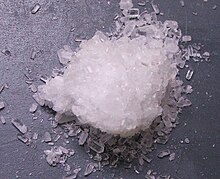User:Mr. Ibrahem/Magnesium sulfate (medical use)
 Magnesium sulfate heptahydrate | |
| Clinical data | |
|---|---|
| Trade names | Epsom salt, others |
| AHFS/Drugs.com | Monograph |
| Routes of administration | IV, IM, by mouth, topical |
| Chemical and physical data | |
| Formula | MgSO4 - 7H2O |
| Molar mass | 120.366 |
| 3D model (JSmol) | |
| |
| |
Magnesium sulfate as a medication is used to treat and prevent low blood magnesium and seizures in women with eclampsia.[2] It is also used in the treatment of torsades de pointes, severe asthma exacerbations, constipation, and barium poisoning.[2][6] It is given by injection into a vein or muscle as well as by mouth.[2][6] As epsom salts, it is also used for mineral baths.[7]
Common side effects include low blood pressure, skin flushing, and low blood calcium.[2] Other side effects may include vomiting, muscle weakness, and decreased breathing.[8] While there is evidence that use during pregnancy may harm the baby, the benefits in certain conditions are greater than the risks.[9] Its use during breastfeeding is deemed to be safe.[9] Magnesium sulfate for medical use is the magnesium sulfate heptahydrate salt.[6] The way it works is not fully understood, but is believed to involve depressing the action of neurons.[2]
Magnesium sulfate came into medical use at least as early as 1618.[10] It is on the World Health Organization's List of Essential Medicines.[11] The wholesale cost in the developing world is about US$0.35–8.73 per 10 ml of 50% solution.[12] In the United Kingdom 4 ml of 20% solution costs the NHS about 10.23 pounds.[6] In the United States a course of medication typically costs less than $25.[3]
References[edit]
- ^ "MAGNESIUM SULFATE = MgSO4 injectable - Essential drugs". medicalguidelines.msf.org. Archived from the original on 28 August 2021. Retrieved 2 September 2020.
- ^ a b c d e f g h "Magnesium Sulfate". The American Society of Health-System Pharmacists. Archived from the original on 21 May 2016. Retrieved 8 January 2017.
- ^ a b Hamilton, Richart (2015). Tarascon Pocket Pharmacopoeia 2015 Deluxe Lab-Coat Edition. Jones & Bartlett Learning. p. 220. ISBN 9781284057560.
- ^ "WHOCC - ATC/DDD Index". www.whocc.no. Archived from the original on 30 September 2020. Retrieved 2 September 2020.
- ^ "WHOCC - ATC/DDD Index". www.whocc.no. Archived from the original on 20 September 2020. Retrieved 2 September 2020.
- ^ a b c d British national formulary : BNF 69 (69 ed.). British Medical Association. 2015. p. 696. ISBN 9780857111562.
- ^ Kogel, Jessica Elzea (2006). Industrial Minerals & Rocks: Commodities, Markets, and Uses. SME. p. 625. ISBN 9780873352338. Archived from the original on 2017-09-18.
- ^ World Health Organization (2009). Stuart MC, Kouimtzi M, Hill SR (eds.). WHO Model Formulary 2008. World Health Organization. p. 75. hdl:10665/44053. ISBN 9789241547659.
- ^ a b "Magnesium sulfate Use During Pregnancy | Drugs.com". www.drugs.com. Archived from the original on 2017-07-02.
- ^ Willett, Edward (2006). Magnesium. The Rosen Publishing Group. p. 5. ISBN 9781404210073. Archived from the original on 2017-09-18.
- ^ World Health Organization (2019). World Health Organization model list of essential medicines: 21st list 2019. Geneva: World Health Organization. hdl:10665/325771. WHO/MVP/EMP/IAU/2019.06. License: CC BY-NC-SA 3.0 IGO.
- ^ "Magnesium Sulfate". International Drug Price Indicator Guide. Archived from the original on 21 November 2018. Retrieved 8 December 2016.
